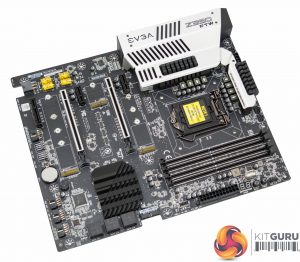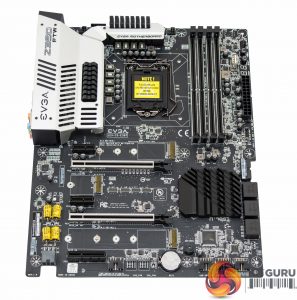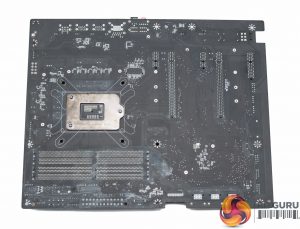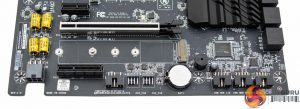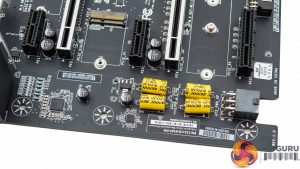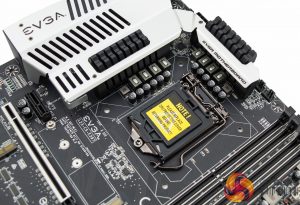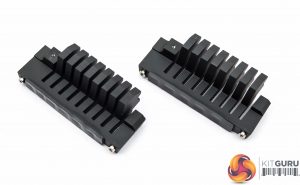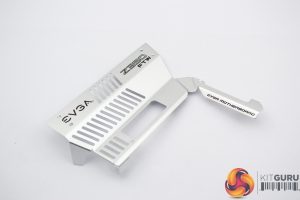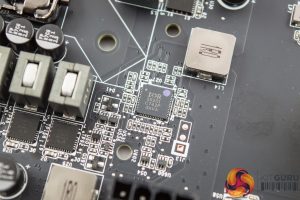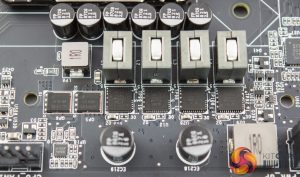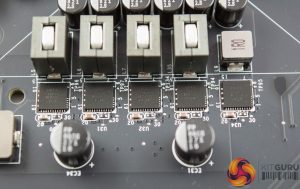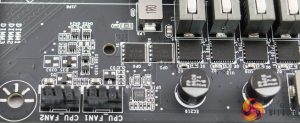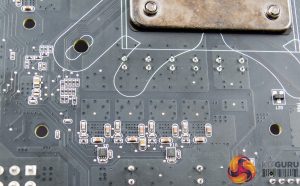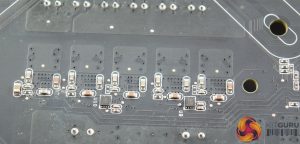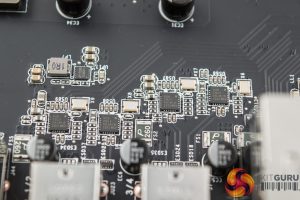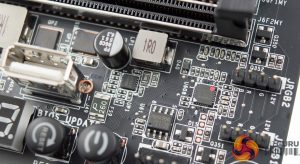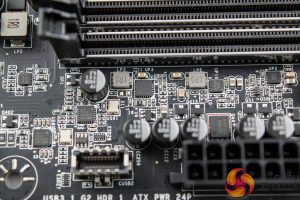EVGA's design of the Z390 FTW is definitely unique, it catches the attention with irregular PCB cut outs, bright yellow audio capacitors and what at first glance appears to be a large CPU heatsink array. As with most modern motherboards black is the colour of the day with silver accenting.
There is no onboard RGB functionality to speak of, which may appeal to many prospective buyers out there with a preference towards simplicity. Regardless, in most scenarios it is better to have onboard RGB lighting that can be turned off by choice, than not to have it at all.
EVGA does provide a pair of 12v G R B connections but 5v Digital Addressable LED strips are not supported.
The underside gives a clearer look at PCIe lane allocation. It's also possible to see that most of the design uses cross-head screws, rather than push-pins, for easy maintenance and modification.
EVGA provides a debug code reader (which doubles as a CPU temperature readout once POST completes), USB flashback port (which allows for a BIOS update without a CPU) and onboard power/reset buttons.
EVGA has been bold about mounting many connections at a right-angle, considerably more than anyone else has attempted before – even fan and USB headers. Presumably this is for cable management purposes, however, it still feels a bit incomplete given that some connectors have not been right-angled, such as the 24pin.
There are USB headers of all generations, 2.0, 3.0 and 3.1, and an adequate storage provision – six SATA III and dual M.2. Supplementary 6 pin PCIe power is provided for the PCIe lanes but is highly unlikely to be needed unless all PCIe slots are being used by power-hungry devices.
The audio section includes four large 100uF capacitors provided by a Taiwanese company, Bennic, that specialises in audio capacitors. The audio codec is the Realtek ALC1220 and it has no shielding, neither is there an isolated PCB for the audio section.
The front panel audio connector is also quite some distance from the audio area, marked up as “CFPA”, as the supplementary 6 pin PCIe power gets in the way.
The rear I/O is fairly well rounded but the observant will see the complete absence of display outputs. EVGA does not provide display outputs since it does not provide motherboard power delivery to support the operation of Intel's integrated graphics, therefore discrete graphics are mandatory.
Given that we are seeing increased adoption of technology like Intel's Quick Sync, which can make use of the integrated graphics for acceleration purposes alongside a discrete GPU, it seems a shame that EVGA have omitted support for integrated graphics.
Given the absence of integrated graphics EVGA is able to dedicate more space and resource towards the CPU VRM. The solution as pictured above, is marketed by EVGA as “11 phase” but the reality is a little different.
The metal shroud which covers the VRM heatsinks does give the impression of a significant cooling area. However, in reality the heatsinks are quite compact and the shroud is more for aesthetics than cooling.
Both heatsinks are of equal size and include a thermal pad. As the 8 VCore phases are split evenly over both sides, 4 phases per heatsink, thermal performance should be quite good.
The PWM controller for the CPU VRM is the Infineon International Rectifier IR35201, a well regarded controller.
In this configuration it appears to operate in 4+1 phase mode with 4 PWM signals being doubled to 8 phases using IR3599 doublers, for the VCore. The extra phase in this 4+1 configuration is likely the VCCSA.
For the 8 VCore phases and single VCCSA phase EVGA is using IR3556M integrated MOSFET packages which combine the high and low-sides.
For the VCCIO phase this makes use of On Semiconductor 4C10N for the high-side and 4C05N for the low-side, controlled by a UPI Semiconductor UP1537p single-phase buck controller.
Combined the above give 10 phases, with another phase provided for the DDR voltage delivery – this is where EVGA derives its marketing tag-line of an “11 phase solution”, 8+1+1+1 (VCore+VCCSA+VCCIO+VDDR).
Four IR3599 doublers are used to turn 4 PWM signals into eight for the 8 VCore VRM phases, these are mounted to the underside of the motherboard.
Four ASM1562 ICs are deployed as re-drivers for the USB 3.1 (10Gbps) Type-A ports.
The memory VRM is provided as another single phase solution using the same uP1537P controller as the VCCIO. There are numerous more different controllers and MOSFETs in use around this part of the motherboard.
The majority of capacitors in use across the motherboard are manufactured by Nichicon and are part of the “FPCAP” series.
Be sure to check out our sponsors store EKWB here
 KitGuru KitGuru.net – Tech News | Hardware News | Hardware Reviews | IOS | Mobile | Gaming | Graphics Cards
KitGuru KitGuru.net – Tech News | Hardware News | Hardware Reviews | IOS | Mobile | Gaming | Graphics Cards


